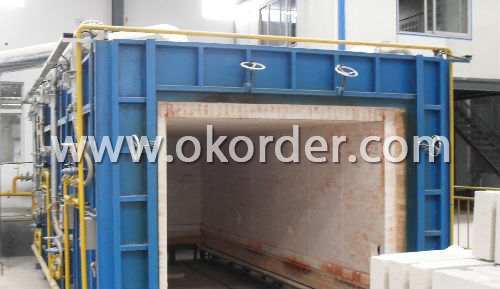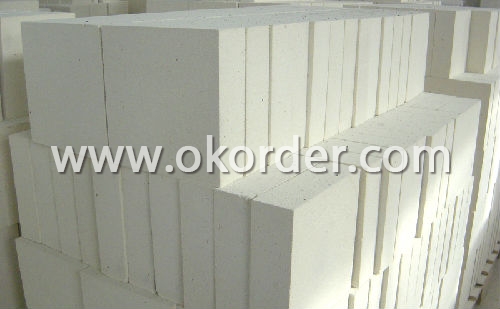Insulating Fire Brick-MS30
- Loading Port:
- China Main Port
- Payment Terms:
- TT or L/C
- Min Order Qty:
- 1000 pcs pc
- Supply Capability:
- 1000 Tons Per Month pc/month
OKorder Service Pledge
OKorder Financial Service
You Might Also Like
General Information of Insulating Fire Bricks MS30
Insulating fire brick MS30 are produced by mixing, extruding, drying, sintering and grinding. Our insulating fire bricks MS30 temperature is 1650℃(3000℉). We could supply a wide range of shapes.
Feature of Insulating Fire Bricks MS30
Light weight and low thermal conductivity
Low heat storage
Low iron and impurities
High thermal shock resistance
Application of Insulating Fire Bricks MS30
The insulating firebricks can be used as a hot face lining directly exposed to the heat or as a backup insulation layer in iron and steel mills, non-ferrous foundries, petrochemical, ceramic, glass.
Data Sheet of Insulating Fire Bricks MS30
|
| MS30 |
Physical Properties: |
|
|
Classifiction Temperature | ℃ | 1600.0 |
Density | Kg/m3 | 1000.0 |
Cold Crushing Strength | Mpa | 2.8 |
Reheating Linear Change(24hrs) |
|
|
1600℃ | % | 0.7 |
Hot Load Strength Deform(90 minutes) |
|
|
1370℃ at 0.069 Mpa(10psi) | % | 0.2 |
Thermal Conductivity |
|
|
400℃ | W/m.k | 0.3 |
600℃ | W/m.k | 0.3 |
800℃ | W/m.k | 0.4 |
1000℃ | W/m.k | 0.4 |
1200℃ | W/m.k | 0.4 |
Specific Heat | KJ/Kg.K | 1.1 |
Chemical Analysis: |
|
|
Al2O3 | % | 70.0 |
SiO2 | % | 28.3 |
Fe2O3 | % | 0.5 |
TiO2 | % | 0.1 |
CaO | % | 0.1 |
MgO | % | 0.1 |
Na2O+K2O | % | 0.7 |


- Q:Can insulating fire bricks be used in space heating applications?
- Indeed, insulating fire bricks can be utilized in space heating scenarios. These bricks possess a design that ensures low thermal conductivity, enabling them to effectively retain and distribute heat within a space heating setup. Crafted from lightweight refractory materials with outstanding insulation properties, these bricks possess the ability to encapsulate heat and prevent its dissipation into the surroundings. Consequently, they prove to be an ideal choice for space heating applications that prioritize energy efficiency. Moreover, insulating fire bricks exhibit a remarkable resilience to high temperatures and thermal shock, rendering them suitable for employment in heating systems that operate at elevated temperatures. All in all, insulating fire bricks emerge as a dependable and efficient alternative for space heating applications.
- Q:How do insulating fire bricks prevent heat transfer?
- Insulating fire bricks prevent heat transfer by their unique composition and structure. They are made of lightweight refractory materials that have low thermal conductivity. This means that they are poor conductors of heat, which helps to minimize the transfer of heat from one side of the brick to the other. Additionally, the bricks are designed with small air pockets or voids, which further reduces heat conduction by trapping air and preventing its movement. The combination of low thermal conductivity and trapped air pockets effectively hinders the transfer of heat, making insulating fire bricks an excellent choice for applications where heat insulation is required.
- Q:What is the typical bulk density of an insulating fire brick?
- The typical bulk density of an insulating fire brick is usually around 0.6 - 1.2 grams per cubic centimeter (g/cm³). However, it is important to note that the actual bulk density may vary depending on the specific composition and manufacturing process of the insulating fire brick.
- Q:Difference between inorganic insulation material and organic thermal insulation material
- The main difference between inorganic insulation materials and organic thermal insulation materials is that the types of insulation materials are different:1, inorganic insulation materials, including glass wool, rock wool, expansion perlite, micro nano insulation board;2, organic insulation materials are mainly polyurethane foam, polystyrene board, phenolic foam and so on.
- Q:Do insulating fire bricks have a high insulation efficiency?
- Indeed, the insulation effectiveness of insulating fire bricks is quite high. These bricks are specifically engineered to possess exceptional thermal insulation properties. They are crafted from lightweight materials with low thermal conductivity, such as various types of refractory clay or alumina. This composition enables them to effectively minimize heat transfer via conduction, thereby making them exceedingly efficient at retaining heat within structures or appliances. Additionally, insulating fire bricks exhibit considerable porosity, which amplifies their insulation capabilities even further. The presence of numerous small air pockets within the bricks diminishes heat transfer through convection, as the air acts as an insulating barrier. This distinct structure aids in maintaining a constant and stable temperature, regardless of whether it is within a furnace, kiln, or any other high-temperature setting. Furthermore, insulating fire bricks possess remarkable resistance to thermal shock, allowing them to endure rapid temperature changes without fracturing or deteriorating. This attribute is particularly vital in applications where temperature fluctuations are commonplace, as it guarantees the longevity and effectiveness of the insulation. In summary, insulating fire bricks are renowned for their exceptional insulation efficiency. They offer superb thermal insulation, prevent heat loss, and contribute to energy conservation. Whether utilized in industrial environments or residential constructions, these bricks deliver reliable insulation performance and enhance the overall energy efficiency of the system in which they are employed.
- Q:Do insulating fire bricks require any special tools for installation?
- Special tools are necessary for installing insulating fire bricks. Some examples of common tools that may be required are a trowel, masonry hammer, chisel, masonry saw, and a masonry drill with the appropriate bits. These tools are essential for cutting the bricks to the desired shape and size and for creating openings or channels for flues, vents, or other components. Additionally, a mortar mix that can withstand high temperatures is needed to securely hold the bricks in place. To ensure a proper and safe installation, it is crucial to carefully follow the manufacturer's instructions and use the recommended tools.
- Q:What is the typical lifespan of insulating fire bricks in high-temperature applications?
- The lifespan of insulating fire bricks in high-temperature applications can differ depending on various factors. These factors include the quality and composition of the bricks, the temperatures they are exposed to, the rate of thermal cycling, and any external factors that may affect their durability. Typically, insulating fire bricks are designed to endure high temperatures and have a longer lifespan compared to regular bricks or other materials. They are usually made from lightweight refractory materials like alumina and silica, which possess excellent thermal insulating properties. In high-temperature applications, insulating fire bricks can last for several years, even decades, when they are properly installed and maintained. However, it is important to note that continuous exposure to extremely high temperatures, rapid temperature changes, or harsh chemical environments can expedite the deterioration of these bricks. Regular inspection and maintenance of insulating fire bricks are essential to ensure their durability. Over time, these bricks may experience thermal shock, erosion, or cracking due to the extreme thermal conditions. By identifying signs of degradation or damage early on, appropriate measures can be taken to repair or replace the affected bricks, thus extending the overall lifespan of the insulation system. Ultimately, the specific lifespan of insulating fire bricks in high-temperature applications can vary significantly and is influenced by different factors. Therefore, it is advisable to seek guidance from manufacturers or industry experts who can provide more accurate estimations based on the specific conditions of your application.
- Q:Are insulating fire bricks suitable for use in kilns and furnaces?
- Insulating fire bricks are a suitable choice for kilns and furnaces, offering excellent thermal insulation that is ideal for applications requiring high temperatures. These bricks are specifically designed to provide outstanding thermal insulation, making them perfect for kilns and furnaces. With their low thermal conductivity, they effectively minimize heat loss, thereby enhancing energy efficiency. Furthermore, their lightweight and durable nature allows for easy installation and long-lasting performance in high-temperature environments. Not only are they resistant to thermal shock, but they also withstand rapid temperature changes, making them a reliable option for kilns and furnaces. Overall, insulating fire bricks are an exceptional choice for insulation and the maintenance of high temperatures in kilns and furnaces.
- Q:What is the refractoriness of insulating fire bricks?
- The refractoriness of insulating fire bricks refers to their ability to withstand high temperatures without losing their structural integrity or undergoing significant thermal expansion. Insulating fire bricks are specifically designed to have a high resistance to heat, making them suitable for applications that involve exposure to extreme temperatures, such as in furnaces, kilns, and fireplaces. The refractoriness of insulating fire bricks is typically measured using the refractoriness under load (RUL) test. This test involves subjecting a sample brick to a predetermined temperature while placing a specified load on it. The RUL is determined by measuring the temperature at which the sample brick exhibits a specified deformation or failure. Insulating fire bricks usually have a high refractoriness, allowing them to withstand temperatures ranging from 1,200 to 1,400 degrees Celsius (2,192 to 2,552 degrees Fahrenheit). This high refractoriness is achieved through the use of special materials and manufacturing techniques that result in a dense and uniform structure with low thermal conductivity. The low thermal conductivity of these bricks helps to minimize heat transfer, making them effective insulators. In addition to their high refractoriness, insulating fire bricks also possess other desirable properties, such as excellent thermal shock resistance, low thermal expansion, and good mechanical strength. These qualities make them ideal for use in applications where maintaining a consistent temperature and preventing heat loss are crucial. Overall, the refractoriness of insulating fire bricks plays a vital role in determining their suitability for high-temperature applications, as it ensures that they can withstand the extreme heat without compromising their structural integrity or insulating properties.
- Q:Can insulating fire bricks be used in refractory linings for boilers?
- Yes, insulating fire bricks can be used in refractory linings for boilers. Insulating fire bricks are specifically designed to have low thermal conductivity, which makes them ideal for applications where heat insulation is required. In boiler systems, insulating fire bricks can be used to line the walls, roof, and floor of the combustion chamber, as well as the flue gas passages. By using insulating fire bricks in these areas, the heat loss from the boiler can be minimized, resulting in improved energy efficiency. Additionally, insulating fire bricks are lightweight and easy to install, making them a convenient choice for boiler refractory linings.
1. Manufacturer Overview |
|
|---|---|
| Location | Jiangsu, China |
| Year Established | 2008 |
| Annual Output Value | Above US$ 35 Million |
| Main Markets | Germany; Italy; Turkey; France; England; Japan; Thailand; Vietnam; Idonesia; USA |
| Company Certifications | ISO 9001:2008 |
2. Manufacturer Certificates |
|
|---|---|
| a) Certification Name | |
| Range | |
| Reference | |
| Validity Period | |
3. Manufacturer Capability |
|
|---|---|
| a)Trade Capacity | |
| Nearest Port | Shanghai; Qingdao |
| Export Percentage | 10% |
| No.of Employees in Trade Department | 3 People |
| Language Spoken: | English; Chinese; |
| b)Factory Information | |
| Factory Size: | Twenty five thousand tons per year |
| No. of Production Lines | Above 5 |
| Contract Manufacturing | OEM Service Offered; Design Service Offered |
| Product Price Range | High; Average |
Send your message to us
Insulating Fire Brick-MS30
- Loading Port:
- China Main Port
- Payment Terms:
- TT or L/C
- Min Order Qty:
- 1000 pcs pc
- Supply Capability:
- 1000 Tons Per Month pc/month
OKorder Service Pledge
OKorder Financial Service
Similar products
New products
Hot products
Related keywords



























